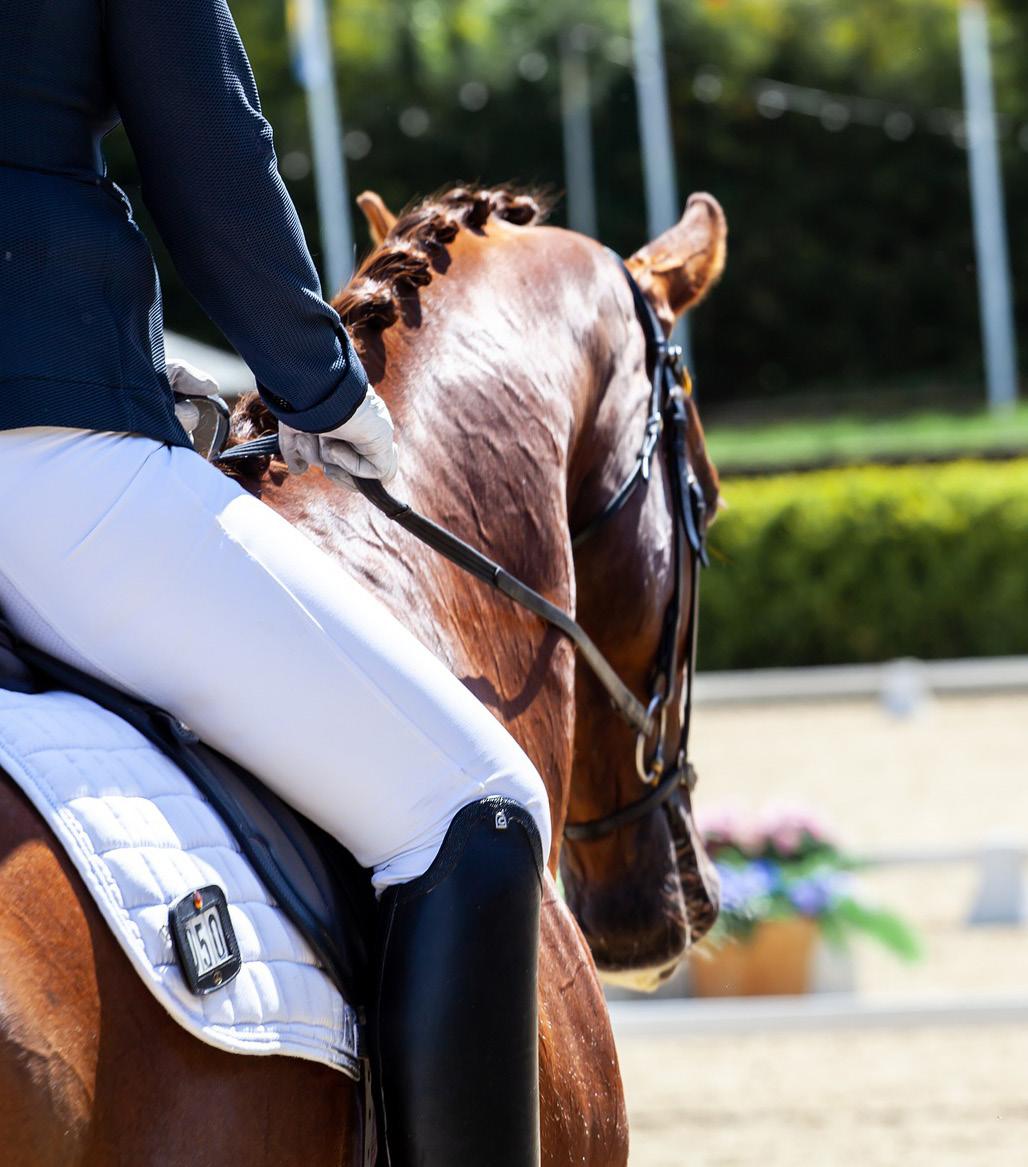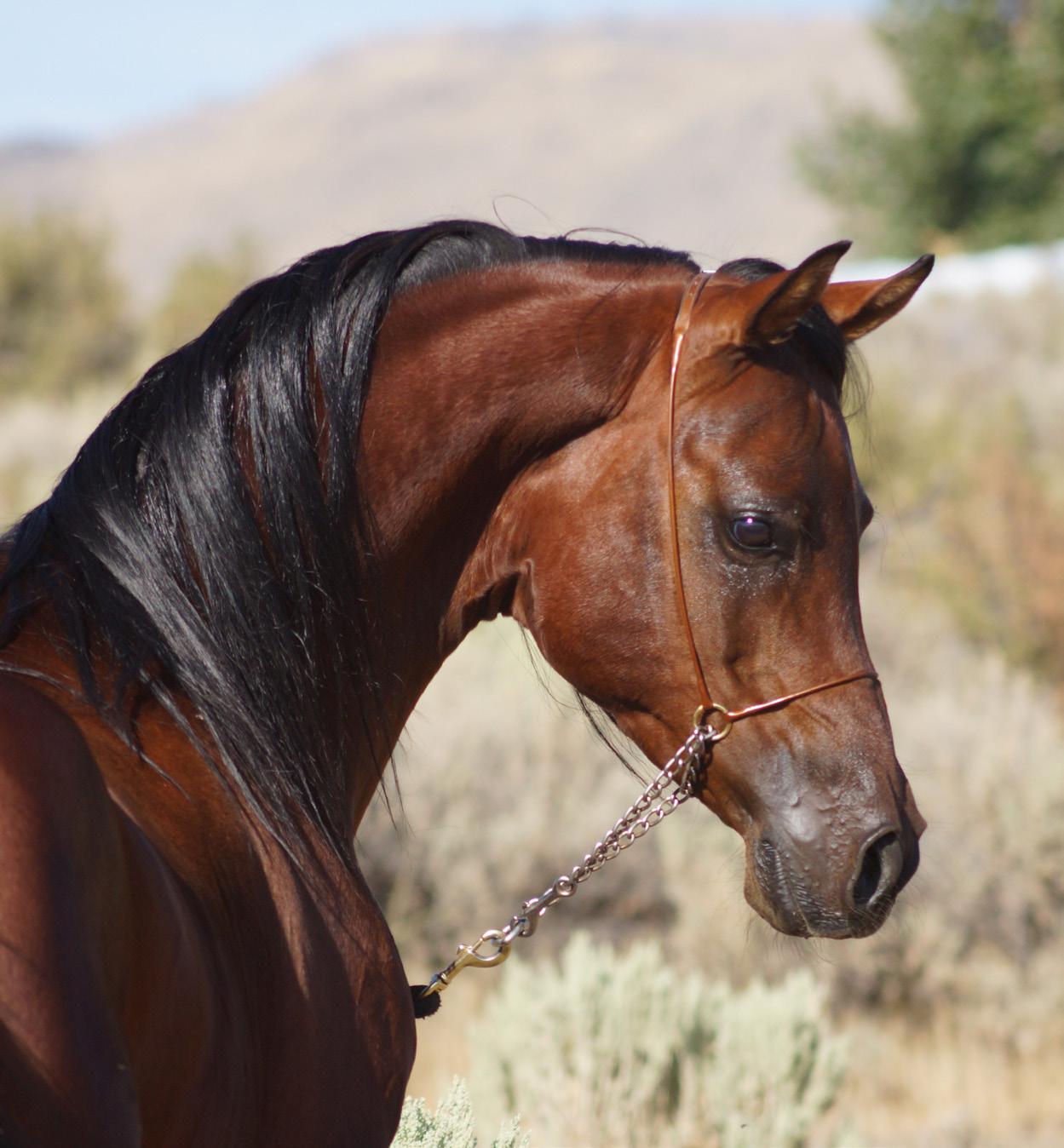
9 minute read
Nutrition: Show season shine
NUTRITION
Nutritional strategies for a shiny show horse
Nutritionist LARISSA BILSTON on keeping your horse cool, calm and collected through the show season.
Good nutrition will reward you with rich coat colour and shine (Main image courtesy Karli Colman, inset from Pixabay).
Producing a show horse in optimal health with the natural gleam of inner health and the calm disposition needed to concentrate on the rider or handler does not happen overnight or by accident. It takes expert attention to detail, focusing on daily diet, gut health, grooming, rugs, training and exercise management to create a glorious and naturally healthy show horse.
Creating coat colour and shine
Nutrition is of critical importance to produce intense coat colour and a natural shine. The most important nutrients for coat condition are copper and zinc (needed to produce melanin pigment), biotin and vitamin B6 (needed to produce keratin, the protein from which hair and hooves are made) and oils (for skin health and shine).
In spring and autumn it’s common to see horses shining with apparent good health, but are they really in optimum condition?
Green grass is rich in natural fats which make the coat shine even if the horse is mineral deficient.
Horses always need mineral supplementation to balance the mineral deficiencies from their forage-based diets and to correctly balance critical mineral ratios. A mineral deficient horse can be ‘healthy’ (in that the horse is not unwell) but it cannot be in optimum health without a well-balanced diet supplying all nutritional needs.
Minerals
Feeding enough copper and zinc will allow the body to make the pigments that can give your horse its best natural coloured hair. The levels of these two minerals also need to be balanced in relation to total dietary iron and manganese intake. When the levels of copper and zinc are not balanced with the iron status of the forage, a horse’s coat can appear lighter than normal, faded or ‘sun-bleached.’
Many horse owners recognise that horses grazing poor quality pasture need supplementation but it is not well understood that even the best quality pasture possible doesn’t give a horse the ideal balance of minerals.

across the entire diet is important to allow the horse to absorb them in the right proportions. The relationships between total intake of calcium and phosphorous, and between copper, zinc, iron and manganese are critical. If mineral ratios are unbalanced, a horse can be deficient in a mineral even when the diet supplies 100% or more of the daily requirement.
How do you know when the diet is right?
The only way to know if your horse’s diet is balanced is to measure or estimate the mineral levels of everything the horse eats and compare the amounts and ratios to the daily nutritional requirements. The Nutritional Requirements of Horses can be found free online in a book of the same name, published by the National Research Council (NRC) in 2007.
Equine nutritionists use computer programs to check total intake and each of the important nutrients. They calculate the critical mineral ratios to check they are within recommended ranges (it is surprising how often they are not).
When choosing a mineral balancer powder, pellet or feed, look for one that balances these ratios over the whole diet. Pre-mixed feeds can only balance mineral levels correctly if used at the recommended rate. Horses fed less than the recommended rate will need a mineral balancer powder or pellet to top up mineral levels.
The implications of providing correct mineral balance run much deeper than just coat colour. Zinc and copper are microminerals necessary for healthy skin, hair and hooves.
Scientific research has shown that the horn from hooves containing lower zinc concentrations are not as hard and strong as those with higher levels of zinc. Zinc is used in more than one hundred enzymes in the body responsible for a large number of cell functions including energy metabolism, cell division and
A nutritionally balanced diet in combination with a good grooming will produce stunning shine (Image from Pixabay).
keratinization (the growth of hair and hooves).

Copper plays an important role in numerous enzymes in the body, including some responsible for connective tissue formation, pigmentation of coat colour, cell respiration and antioxidant functions.
What about sun-bleaching?
The term ‘a sun-bleached appearance’ is often used to describe a coat that is lighter than it was genetically designed to be due to a diet deficient in copper or containing unbalanced copper, zinc, iron and manganese levels. However, sunlight does react with sweat on the coat resulting in true bleaching even when the mineral balance of the diet is correct. The UV rays from the sun damage melanin, the pigment that colours hair. The salt in sweat strips the protective oils and waxes from the hair cuticle, so that individual hairs stand upright with exposed, rough surfaces that give the coat a dry, rough appearance.
To prevent true sun-bleaching it is necessary to hose sweat off thoroughly every day in addition to feeding a correctly balanced diet. paddock management and hoof care practices will lead to the growth of the best mane, tail and hoof tissue that a horse is genetically programmed to produce.
Oils ain’t oils
Even when a grazing horse is apparently shining with good health, the diet will be mineral deficient unless supplemented. The shine in that instance comes from the naturally occurring oils in the grass regardless of the mineral balance of the diet.
Whilst any type of oil in the diet can help with shine, a healthy diet for a horse will balance the polyunsaturated fatty acid ratios towards the levels and ratios naturally found in grass. Grass contains about four times the amount of antiinflammatory omega-3 fatty acids than it does omega-6.
Dried grass (hay and chaff), grains and most other vegetable oils (including canola and sunflower seeds or oil) are much higher in pro-inflammatory omega-6 compared to omega-3. A horse eating lots of hay or hard feed needs more omega-3 added to the diet to increase the omega 3 to 6 ratio to a level similar to grass. Omega-3 rich supplements containing linseeds, stabilised linseed oil, DHA rich algal meal or fish oils are necessary if your horse is relying on hay for roughage, or is on a high grain diet.
Marine-sourced forms of omega-3 (DHA and EPA) provide unique health benefits. EPA omega-3s are particularly potent in promoting healthy skin and connective tissue. DHA is essential for brain and nervous system function. These omega3s are particularly useful for helping to manage itchy skin, arthritis, respiratory disease and other inflammatory conditions.
Grooming
The old adage that elbow grease creates a shining coat is true. Grooming stimulates blood flow to the skin which in turn nourishes the hair follicle. Harder brushes stimulate the skin’s natural oil production from the sebaceous glands. Soft brushes distribute the oils along the hair follicle, smoothing the cuticle scales and creating a sleek, shining coat.
Silicone ‘show shine’ sprays also coat and smooth down the outer scales on the hair cuticle, but they do tend to attract dust and can be sticky to touch.
Transport, stress and gastric ulcers
Even short periods of transportation can be stressful to horses and cause detrimental changes to gut microbes and the gut lining, increasing the risk of gastric disturbance and ulcers.
Research has found that as little as two hours of transport alters the balance of microbial species in manure and lowers its pH, as well as changing the white blood cell concentrations. These changes indicate physiological stress even in
horses who travel frequently and appear outwardly calm. Horses unused to long periods spent in a stable can experience similar levels of stress when stabled at competitions.
Stress affects the gut muscles and can cause cramping, spasms, bloating, diarrhea, as well as slowing the passage of food. It reduces the efficiency of digestion, weakens the cells in the intestinal mucosa (leaky gut) and impacts on the gut microbial population which further affects digestive efficiency, gut acidity, immune function and hormone signaling.
Supplementation with the live yeast Saccharomyces cerevisiae or specific Lactobacillus bacterial species maintains the natural diversity of hindgut bacterial populations. This reduces the levels of lactic acid built up during transport and maintains a more stable hindgut pH level which can reduce pain and prevent the loss of vitamin production that occurs when beneficial microbes die in a more acidic hindgut.
Scientific trials have confirmed that feeding horses a specific strain of live yeast (Saccharomyces cerevisiae) reduces the impact of transport stress on gut microbial populations and reduces the levels of stress hormones measured in the blood during transportation.
Transport stress may cause oxidative stress at a cellular level, leaving the body undersupplied with the antioxidants that prevent free radicals from causing tissue damage in muscles, airways and gut linings. Feeding additional antioxidants including organic selenium and vitamins C and E before and after transport reduces the impact of oxidative stress.
Stress also causes a reduction in the number of specialised cells that exist in the horse’s airways for the process of clearing contamination from the lungs, thereby increasing the risk of travel sickness and respiratory infections.
As a result of stress, transported horses may have a weaker immune system, be more prone to gut pain and colic, and experience nervous system dysfunction that may result in behavioural changes. ABOVE: For an optimum show-ready appearance, horses need mineral supplementation to balance deficiencies in their forage based diets (Image from Pixabay). BELOW: Healthy gut, happy horse. Consider supplementing to maintain the natural diversity of hindgut bacterial populations (Image from Pixabay).
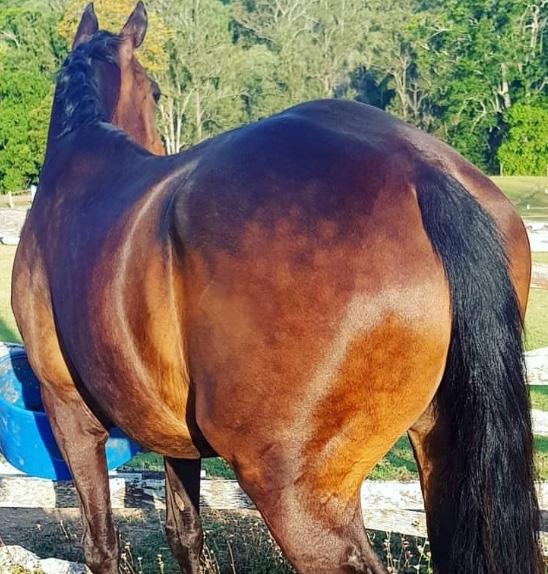
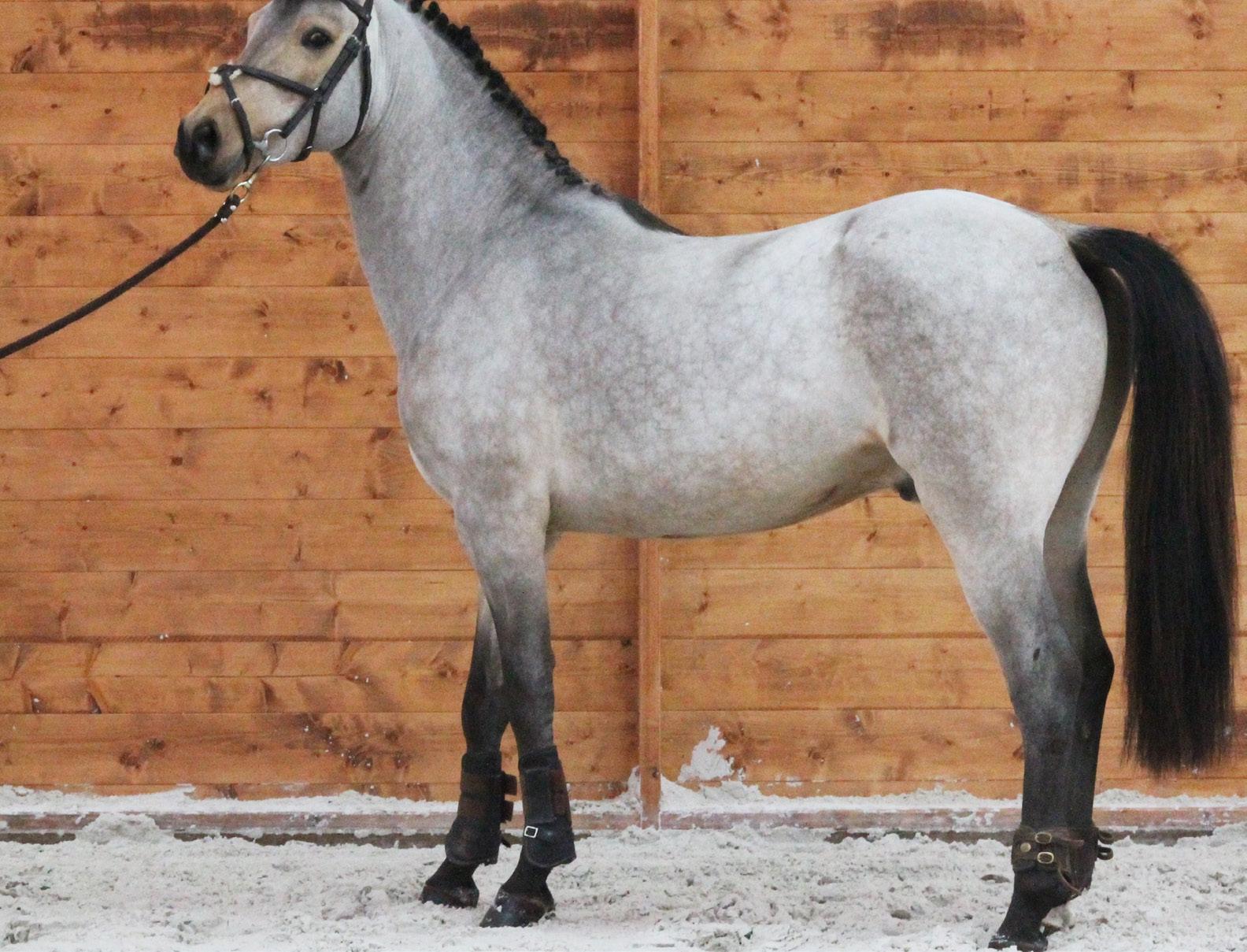

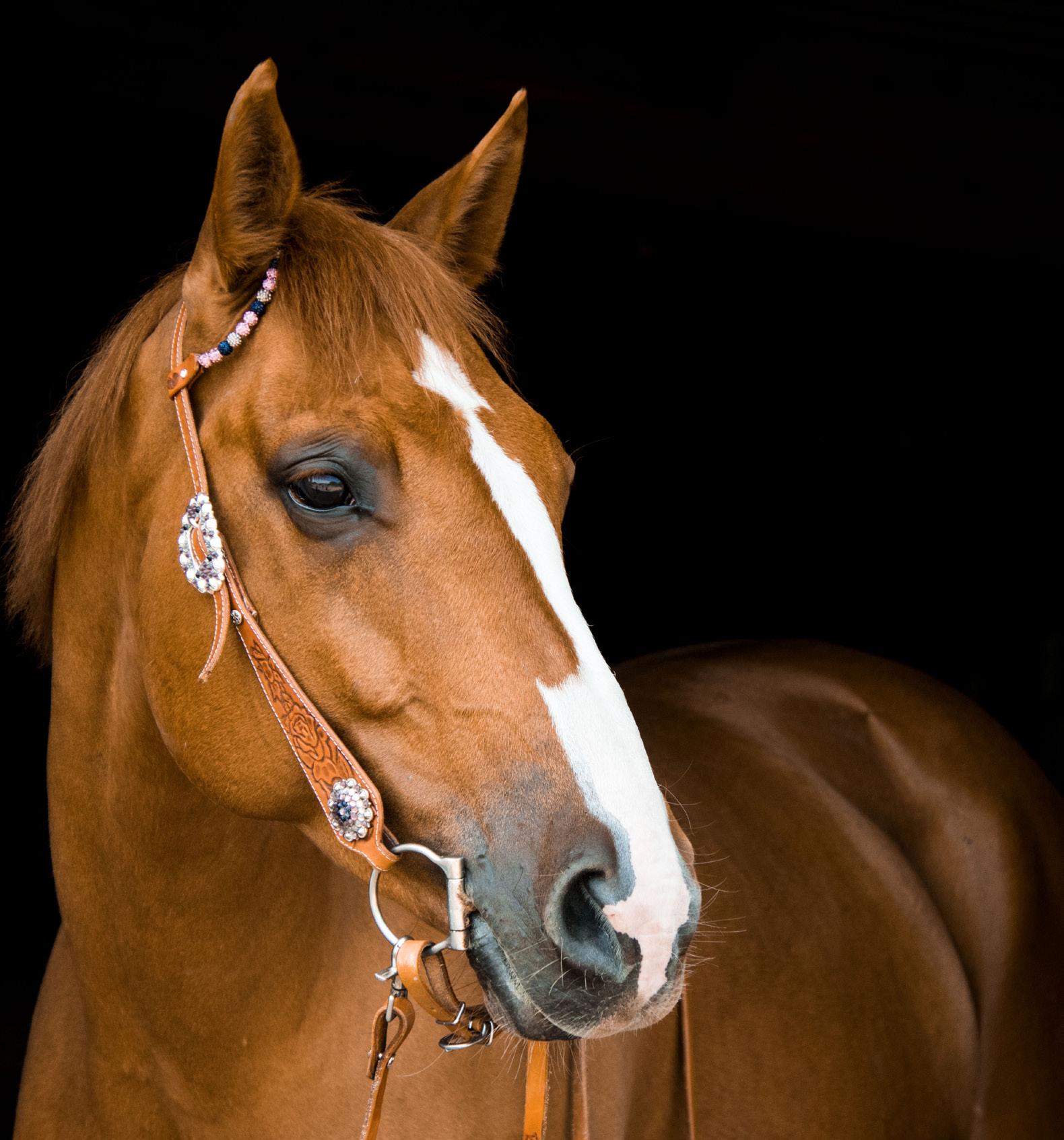
can form in an empty stomach during a period as short as four hours, or in only a few hours of transport where stress is an exacerbating factor.
Probiotics and the gut-brain axis
Exciting new research is emerging to demonstrate the significant influence of the gut microbial population on animal health and behavior. Disruption to the balance of gut microbial species (as occurs during stress) has been demonstrated to cause behavioral change in some species.
Animals treated with probiotics have measurably lower levels of corticosterone, a stress hormone. Scientists believe that supplementation with probiotics to improve digestive comfort is a plausible strategy which could contribute to behavior modification in horses. Supplementation with live yeast Saccharomyces cerevisiae or specific Lactobacillus bacterial species maintains the natural diversity of hindgut bacterial populations. This reduces the levels of lactic acid and maintains a more stable hindgut pH which could reduce the impact of stress on the gut and avoid deficiencies in the vitamins and amino acids normally provided by a healthy hindgut microbiome.
Omega-3 fatty acids
Scientists researching dietary polyunsaturated fatty acids have found that omega-3s in the form of DHA and its precursor, EPA, can improve cognitive function in humans. Research from many species demonstrates that DHA is essential for normal brain development before and after birth. New work is linking EPA to mood and behavior. Perhaps in future we will see research linking marine-sourced omega-3 supplementation (DHA and EPA) to improved horse behavior and learning!
No matter what your discipline, a balanced, nutrient-rich diet will reward you with a healthy, happy horse (Images from Pixabay).
